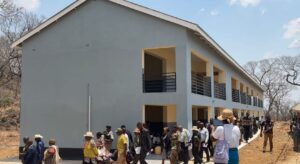HIV in the 21st Century: Progress, Challenges, and Hope for an AIDS-Free Generation

Screenshot
Health Matters – Four decades ago, the letters “HIV” and “AIDS” inspired fear and despair across the world.
The virus was then a mystery, its diagnosis a death sentence. Today, in the 21st century, science, resilience, and human will have transformed that grim narrative into one of hope. Yet, despite tremendous progress, the fight against HIV is not over.
The early 1980s were marked by confusion and loss. Millions died as the world struggled to understand and respond to a virus that attacked the immune system and destroyed lives indiscriminately. But as the decades passed, medical science caught up.
The discovery of antiretroviral therapy (ART) in the mid-1990s changed everything.
Now, with consistent treatment, a person living with HIV can enjoy a near-normal life expectancy.
Even more groundbreaking is the fact that when treatment reduces the virus to undetectable levels in the blood, it becomes untransmittable — a global campaign known as U=U (Undetectable = Untransmittable) has been central in reshaping attitudes and understanding.
New Tools for Prevention
In the 21st century, prevention has advanced hand in hand with treatment. Pre-Exposure Prophylaxis (PrEP), a daily pill or periodic injection taken by HIV-negative people at high risk, has reduced transmission rates by up to 99%.
Post-Exposure Prophylaxis (PEP), meanwhile, offers a vital safety net after accidental exposure, if taken within 72 hours.
These innovations have given individuals more control over their health than ever before.
“The introduction of PrEP and the accessibility of ART have revolutionized our national HIV response,” says a health officer in Manicaland Province. “People now know that HIV prevention and treatment are not just medical issues — they’re about empowerment, awareness, and dignity.”
Once considered the epicentre of the epidemic, sub-Saharan Africa has become the global model for HIV response.
Countries like Zimbabwe, Botswana, and Rwanda have achieved remarkable progress toward the UNAIDS 95-95-95 targets — ensuring that 95% of people living with HIV know their status, 95% of those are on treatment, and 95% of those on treatment have suppressed viral loads.
Zimbabwe, in particular, has made significant strides. Decades of sustained public education, combined with the efforts of government, NGOs, and community-based organisations, have reduced infections and improved treatment adherence.
The country’s health system, despite economic challenges, has shown resilience through innovative programmes such as community ART refill groups and mobile testing initiatives.
According to UNAIDS, new HIV infections globally have dropped by more than half since the 1990s. More than 29 million people are now accessing life-saving antiretroviral therapy — a testament to science, solidarity, and perseverance.
Yet, even amid success, the virus continues to claim lives. Over 39 million people worldwide are still living with HIV, and more than 1.3 million new infections occur each year.
In many communities, stigma and discrimination remain as dangerous as the virus itself.
Young women and adolescent girls in sub-Saharan Africa are among the most vulnerable. Gender inequality, limited access to sexual education, and poverty continue to drive new infections.
For many, negotiating safer sex or accessing preventive medication is not a simple choice — it’s constrained by social and economic realities.
Health experts also warn against complacency. “We are winning the medical battle, but the social war is far from over,” says a local counsellor in Nyanga. “People are still afraid to test or disclose their status because of judgement. Until stigma ends, we will never truly defeat HIV.”
The 21st century has brought digital power to the fight.
Mobile apps now remind patients to take medication, telemedicine connects rural communities to specialists, and social media campaigns have normalized open conversations around HIV.
Hashtags such as #KnowYourStatus, #UequalsU, and #EndAIDS have turned online platforms into tools for education and advocacy.
Younger generations are increasingly informed, and that awareness is paying off. The narrative has shifted from fear to responsibility — from silence to visibility.
However, misinformation and myths still circulate online, making accurate health communication an ongoing priority.
Beyond statistics and science are human stories — stories of endurance, love, and survival. Many who once thought their lives were over now live full, productive lives, raising families and contributing to their communities.
Access to ART has allowed millions to dream again, proving that HIV is no longer a life-ending condition but a life-changing one.
Support networks have also strengthened the fight. Community caregivers, peer educators, and activists continue to provide psychosocial support, home-based care, and education.
Their grassroots work — often in rural and underserved areas — remains the unsung backbone of HIV response efforts.
Globally, scientists continue to push boundaries. The stories of the “Berlin Patient” and the “London Patient”, both functionally cured of HIV following complex stem cell transplants, have shown that a cure is possible.
Although these methods are not yet practical for widespread use, they mark a new frontier in HIV research.
Meanwhile, promising trials for HIV vaccines and long-acting injectables continue, offering hope for simpler, more accessible treatment regimens in the near future.
The global health community has set a bold target — to end AIDS as a public health threat by 2030. Reaching that goal requires more than medication; it demands political commitment, equitable healthcare systems, and social justice. Investment in prevention, education, and gender equality remains crucial.
HIV does not exist in isolation. It intersects with broader issues — poverty, migration, education, and human rights. Ending it, therefore, means addressing the inequalities that sustain it.
The story of HIV in the 21st century is not just medical — it’s deeply human. It’s about courage in the face of fear, progress against the odds, and communities uniting to protect one another.
We may not yet have a cure, but we have something just as powerful: knowledge, compassion, and commitment. The virus may have shaped a generation, but it will not define the next.
As the world looks toward 2030, one truth remains clear — with continued science, solidarity, and compassion, an AIDS-free generation is not just a dream. It’s within reach.




